

SPF-p.q
Schematic of SPF-2.4 with Example Data
Level S b1
b2 b3 b4
a1 s1
s2
s3
s4
3
6
3
3
4
5
4
3
7
8
7
6
7
8
9
8
a2 s5
s6
s7
s81
2
2
2
2
3
4
35
6
5
610
10
9
11
Or in abbreviated form.
| Level | b1 | b2 | b3 | b4 |
| a1 | S1 n = 4 | S1 n = 4 | S1 n = 4 | S1 n = 4 |
| a2 | S2 n = 4 | S2 n = 4 | S2 n = 4 | S2 n = 4 |
Linear Model
Yijk = μ + αj + πi(j) + βk + αβjk + βπki(j) + εijk
where
μ = overall poulation mean
αj = the effect of treatment level j
πi = the effect of block i
βk = the effect of treatment level k
αβjk = the joint effects of treatment levels j & k
βπki(j) = the effect of treatment level k & block i nested in j of A
εijk = experimental error
Hypotheses



Assumptions
Independence
Normality
Homogeneity of Variance
Independence
Normality
Compound Symmetry in the Variance-Covariance Matrix
No nonadditivity
ANOVA Summary Table
| Source | SS | df | MS | F | p-value | Error | |
| Between Blocks | |||||||
| 1 | A | 3.125 | 1 | 3.125 | 2.00 | .2070 | [2] |
| 2 | Blks(A) | 9.375 | 6 | 1.562 | |||
| Within Blocks | |||||||
| 3 | B | 194.500 | 3 | 64.833 | 127.88 | .0000 | [5] |
| 4 | A*B | 19.375 | 3 | 6.458 | 12.74 | .0001 | [5] |
| 5 | B*Blks(A) | 9.125 | 18 | 0.507 | |||
| Total | 235.500 | 31 | |||||
Expected Mean Squares
E(MS a) = σ2ε + qσ2π + nqσ2α E(MS blks(a)) = σ2ε + qσ2π E(MS b) = σ2ε + σ2βπ + npσ2β E(MS a#b) = σ2ε + σ2βπ + nσ2αβ E(MS b#blks(a)) = σ2ε + σ2βπ
Strength of Association
F-ratio is not significant, do not compute omega2 for A.
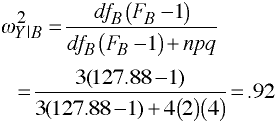
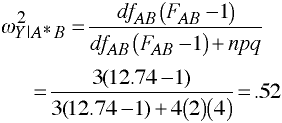
Using Stata
input y a b s x1 x2 x3 x4 s1 s2 s3 s4 s5 s6
3 1 1 1 1 1 1 1 1 1 1 0 0 0
6 1 1 2 1 1 1 1 -1 1 1 0 0 0
3 1 1 3 1 1 1 1 0 -2 1 0 0 0
3 1 1 4 1 1 1 1 0 0 -3 0 0 0
1 2 1 5 -1 1 1 1 0 0 0 1 1 1
2 2 1 6 -1 1 1 1 0 0 0 -1 1 1
2 2 1 7 -1 1 1 1 0 0 0 0 -2 1
2 2 1 8 -1 1 1 1 0 0 0 0 0 -3
4 1 2 1 1 -1 1 1 1 1 1 0 0 0
5 1 2 2 1 -1 1 1 -1 1 1 0 0 0
4 1 2 3 1 -1 1 1 0 -2 1 0 0 0
3 1 2 4 1 -1 1 1 0 0 -3 0 0 0
2 2 2 5 -1 -1 1 1 0 0 0 1 1 1
3 2 2 6 -1 -1 1 1 0 0 0 -1 1 1
4 2 2 7 -1 -1 1 1 0 0 0 0 -2 1
3 2 2 8 -1 -1 1 1 0 0 0 0 0 -3
7 1 3 1 1 0 -2 1 1 1 1 0 0 0
8 1 3 2 1 0 -2 1 -1 1 1 0 0 0
7 1 3 3 1 0 -2 1 0 -2 1 0 0 0
6 1 3 4 1 0 -2 1 0 0 -3 0 0 0
5 2 3 5 -1 0 -2 1 0 0 0 1 1 1
6 2 3 6 -1 0 -2 1 0 0 0 -1 1 1
5 2 3 7 -1 0 -2 1 0 0 0 0 -2 1
6 2 3 8 -1 0 -2 1 0 0 0 0 0 -3
7 1 4 1 1 0 0 -3 1 1 1 0 0 0
8 1 4 2 1 0 0 -3 -1 1 1 0 0 0
9 1 4 3 1 0 0 -3 0 -2 1 0 0 0
8 1 4 4 1 0 0 -3 0 0 -3 0 0 0
10 2 4 5 -1 0 0 -3 0 0 0 1 1 1
10 2 4 6 -1 0 0 -3 0 0 0 -1 1 1
9 2 4 7 -1 0 0 -3 0 0 0 0 -2 1
11 2 4 8 -1 0 0 -3 0 0 0 0 0 -3
end
tabulate a, summ(y)
| Summary of y
a | Mean Std. Dev. Freq.
------------+------------------------------------
1 | 5.6875 2.120338 16
2 | 5.0625 3.3159966 16
------------+------------------------------------
Total | 5.375 2.7562246 32
tabulate b, summ(y)
| Summary of y
b | Mean Std. Dev. Freq.
------------+------------------------------------
1 | 2.75 1.4880476 8
2 | 3.5 .9258201 8
3 | 6.25 1.0350983 8
4 | 9 1.3093073 8
------------+------------------------------------
Total | 5.375 2.7562246 32
table a, cont(freq mean y sd y) by(b)
----------+-----------------------------------
b and a | Freq. mean(y) sd(y)
----------+-----------------------------------
1 |
1 | 4 3.75 1.5
2 | 4 1.75 .5
----------+-----------------------------------
2 |
1 | 4 4 .8164966
2 | 4 3 .8164966
----------+-----------------------------------
3 |
1 | 4 7 .8164966
2 | 4 5.5 .5773503
----------+-----------------------------------
4 |
1 | 4 8 .8164966
2 | 4 10 .8164966
----------+-----------------------------------
histogram y, by(a) normal
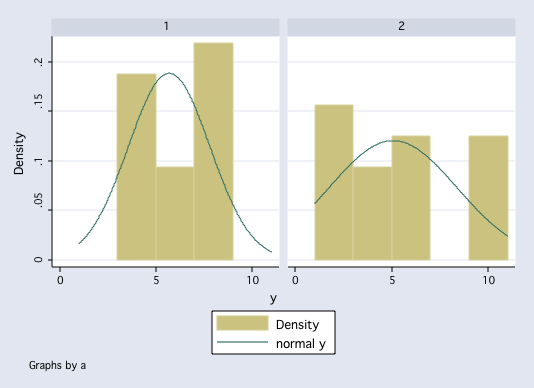 histogram y, by(b) normal
histogram y, by(b) normal
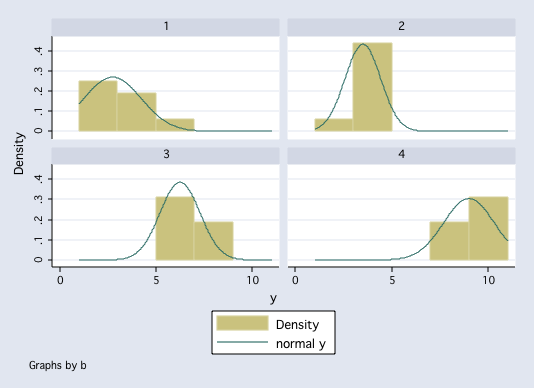 histogram y, by(a b) normal
histogram y, by(a b) normal
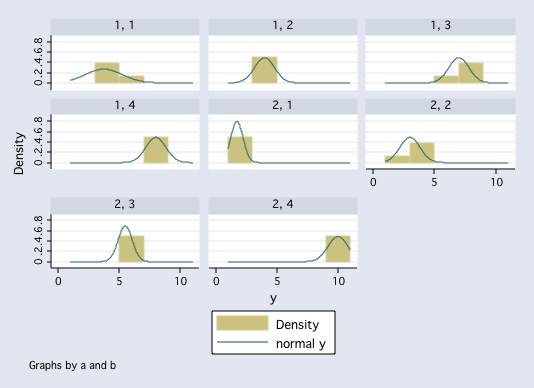 anova y a / s|a b a#b / , repeated(b)
Number of obs = 32 R-squared = 0.9613
Root MSE = .712 Adj R-squared = 0.9333
Source | Partial SS df MS F Prob > F
-----------+----------------------------------------------------
Model | 226.375 13 17.4134615 34.35 0.0000
|
a | 3.125 1 3.125 2.00 0.2070
s|a | 9.375 6 1.5625
-----------+----------------------------------------------------
b | 194.5 3 64.8333333 127.89 0.0000
a#b | 19.375 3 6.45833333 12.74 0.0001
|
Residual | 9.125 18 .506944444
-----------+----------------------------------------------------
Total | 235.5 31 7.59677419
Between-subjects error term: s|a
Levels: 8 (6 df)
Lowest b.s.e. variable: s
Covariance pooled over: a (for repeated variable)
Repeated variable: b
Huynh-Feldt epsilon = 0.9432
Greenhouse-Geisser epsilon = 0.5841
Box's conservative epsilon = 0.3333
------------ Prob > F ------------
Source | df F Regular H-F G-G Box
-----------+----------------------------------------------------
b | 3 127.89 0.0000 0.0000 0.0000 0.0000
a#b | 3 12.74 0.0001 0.0002 0.0019 0.0118
Residual | 18
----------------------------------------------------------------
quietly anova y a b a#b /* needed to obtain graphs */
anovaplot b a, scatter(msym(none))
anova y a / s|a b a#b / , repeated(b)
Number of obs = 32 R-squared = 0.9613
Root MSE = .712 Adj R-squared = 0.9333
Source | Partial SS df MS F Prob > F
-----------+----------------------------------------------------
Model | 226.375 13 17.4134615 34.35 0.0000
|
a | 3.125 1 3.125 2.00 0.2070
s|a | 9.375 6 1.5625
-----------+----------------------------------------------------
b | 194.5 3 64.8333333 127.89 0.0000
a#b | 19.375 3 6.45833333 12.74 0.0001
|
Residual | 9.125 18 .506944444
-----------+----------------------------------------------------
Total | 235.5 31 7.59677419
Between-subjects error term: s|a
Levels: 8 (6 df)
Lowest b.s.e. variable: s
Covariance pooled over: a (for repeated variable)
Repeated variable: b
Huynh-Feldt epsilon = 0.9432
Greenhouse-Geisser epsilon = 0.5841
Box's conservative epsilon = 0.3333
------------ Prob > F ------------
Source | df F Regular H-F G-G Box
-----------+----------------------------------------------------
b | 3 127.89 0.0000 0.0000 0.0000 0.0000
a#b | 3 12.74 0.0001 0.0002 0.0019 0.0118
Residual | 18
----------------------------------------------------------------
quietly anova y a b a#b /* needed to obtain graphs */
anovaplot b a, scatter(msym(none))
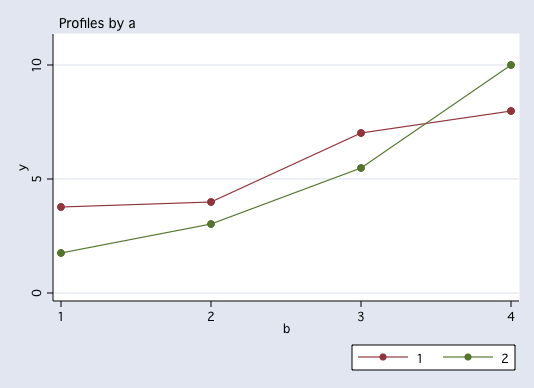 anovaplot a b, scatter(msym(none))
anovaplot a b, scatter(msym(none))
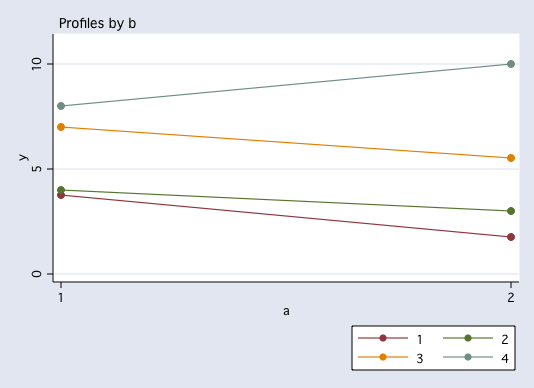
Using Stata: Regression with Orthogonal Coding
generate x5=x1*x2
generate x6=x1*x3
generate x7=x1*x4
regress y x1 x2 x3 x4 x5 x6 x7 s1 s2 s3 s4 s5 s6
Source | SS df MS Number of obs = 32
-------------+------------------------------ F( 13, 18) = 34.35
Model | 226.375 13 17.4134615 Prob > F = 0.0000
Residual | 9.125 18 .506944444 R-squared = 0.9613
-------------+------------------------------ Adj R-squared = 0.9333
Total | 235.5 31 7.59677419 Root MSE = .712
------------------------------------------------------------------------------
y | Coef. Std. Err. t P>|t| [95% Conf. Interval]
-------------+----------------------------------------------------------------
x1 | .3125 .1258651 2.48 0.023 .0480673 .5769327
x2 | -.375 .1780001 -2.11 0.049 -.7489643 -.0010357
x3 | -1.041667 .1027684 -10.14 0.000 -1.257575 -.8257583
x4 | -1.208333 .0726682 -16.63 0.000 -1.361004 -1.055663
x5 | .25 .1780001 1.40 0.177 -.1239643 .6239643
x6 | 0 .1027684 0.00 1.000 -.2159084 .2159084
x7 | .4375 .0726682 6.02 0.000 .2848297 .5901703
s1 | -.75 .2517301 -2.98 0.008 -1.278865 -.2211346
s2 | .0833333 .1453365 0.57 0.573 -.2220072 .3886739
s3 | .2291667 .1027684 2.23 0.039 .0132583 .445075
s4 | -.375 .2517301 -1.49 0.154 -.9038654 .1538654
s5 | -.0416667 .1453365 -0.29 0.778 -.3470072 .2636739
s6 | -.1458333 .1027684 -1.42 0.173 -.3617417 .070075
_cons | 5.375 .1258651 42.70 0.000 5.110567 5.639433
------------------------------------------------------------------------------
test2 x1 / s1 s2 s3 s4 s5 s6
Testing: x1
Error term: s1 s2 s3 s4 s5 s6
F( 1, 6) = 2.00
Prob > F = 0.2070
test x2 x3 x4
( 1) x2 = 0
( 2) x3 = 0
( 3) x4 = 0
F( 3, 18) = 127.89
Prob > F = 0.0000
test x5 x6 x7
( 1) x5 = 0
( 2) x6 = 0
( 3) x7 = 0
F( 3, 18) = 12.74
Prob > F = 0.0001
Using Stata: Data in Wide Forminput s a y1 y2 y3 y4 1 1 3 4 7 7 2 1 6 5 8 8 3 1 3 4 7 9 4 1 3 3 6 8 5 2 1 2 5 10 6 2 2 3 6 10 7 2 2 4 5 9 8 2 2 3 6 11
The Multivariate Approach
Using the manova command.
manova y1 y2 y3 y4 = a
Number of obs = 8
W = Wilks' lambda L = Lawley-Hotelling trace
P = Pillai's trace R = Roy's largest root
Source | Statistic df F(df1, df2) = F Prob>F
-----------+--------------------------------------------------
a | W 0.1374 1 4.0 3.0 4.71 0.1169 e
| P 0.8626 4.0 3.0 4.71 0.1169 e
| L 6.2764 4.0 3.0 4.71 0.1169 e
| R 6.2764 4.0 3.0 4.71 0.1169 e
|--------------------------------------------------
Residual | 6
-----------+--------------------------------------------------
Total | 7
--------------------------------------------------------------
e = exact, a = approximate, u = upper bound on
mat ymat = (1,0,0,-1\0,1,0,-1\0,0,1,-1)
mat list ymat
ymat[3,4]
c1 c2 c3 c4
r1 1 0 0 -1
r2 0 1 0 -1
r3 0 0 1 -1
/* test of the y#a interaction */
manovatest a, ytransform(ymat)
Transformations of the dependent variables
(1) y1 - y4
(2) y2 - y4
(3) y3 - y4
W = Wilks' lambda L = Lawley-Hotelling trace
P = Pillai's trace R = Roy's largest root
Source | Statistic df F(df1, df2) = F Prob>F
-----------+--------------------------------------------------
a | W 0.1443 1 3.0 4.0 7.91 0.0371 e
| P 0.8557 3.0 4.0 7.91 0.0371 e
| L 5.9296 3.0 4.0 7.91 0.0371 e
| R 5.9296 3.0 4.0 7.91 0.0371 e
|--------------------------------------------------
Residual | 6
--------------------------------------------------------------
e = exact, a = approximate, u = upper bound on F
/* test of y */
mat xmat = (1, .5, .5)
mat list xmat
xmat[1,3]
c1 c2 c3
r1 1 .5 .5
manovatest, test(xmat) ytransform(ymat)
Transformations of the dependent variables
(1) y1 - y4
(2) y2 - y4
(3) y3 - y4
Test constraint
(1) _cons + .5 a[1] + .5 a[2] = 0
W = Wilks' lambda L = Lawley-Hotelling trace
P = Pillai's trace R = Roy's largest root
Source | Statistic df F(df1, df2) = F Prob>F
-----------+--------------------------------------------------
manovatest | W 0.0275 1 3.0 4.0 47.19 0.0014 e
| P 0.9725 3.0 4.0 47.19 0.0014 e
| L 35.3944 3.0 4.0 47.19 0.0014 e
| R 35.3944 3.0 4.0 47.19 0.0014 e
|--------------------------------------------------
Residual | 6
-------------------------------------------------------------Wide to Long
reshape long y, i(s) j(b)
(note: j = 1 2 3 4)
Data wide -> long
-----------------------------------------------------------------------------
Number of obs. 8 -> 32
Number of variables 6 -> 4
j variable (4 values) -> b
xij variables:
y1 y2 ... y4 -> y
-----------------------------------------------------------------------------
describe
Contains data
obs: 32
vars: 4
size: 544 (96.8% of memory free)
-------------------------------------------------------------------------------
1. s float %9.0g
2. b byte %9.0g
3. a float %9.0g
4. y float %9.0g
-------------------------------------------------------------------------------
Sorted by: s b
Note: dataset has changed since last saved
tab1 a b s
-> tabulation of a
a | Freq. Percent Cum.
------------+-----------------------------------
1 | 16 50.00 50.00
2 | 16 50.00 100.00
------------+-----------------------------------
Total | 32 100.00
-> tabulation of b
b | Freq. Percent Cum.
------------+-----------------------------------
1 | 8 25.00 25.00
2 | 8 25.00 50.00
3 | 8 25.00 75.00
4 | 8 25.00 100.00
------------+-----------------------------------
Total | 32 100.00
-> tabulation of s
s | Freq. Percent Cum.
------------+-----------------------------------
1 | 4 12.50 12.50
2 | 4 12.50 25.00
3 | 4 12.50 37.50
4 | 4 12.50 50.00
5 | 4 12.50 62.50
6 | 4 12.50 75.00
7 | 4 12.50 87.50
8 | 4 12.50 100.00
------------+-----------------------------------
Total | 32 100.00
The Univariate Anova Approach
The univariate anova approach would uses the anova command like this.
anova y a / s|a b a#b /, repeat(b)
Number of obs = 32 R-squared = 0.9613
Root MSE = .712 Adj R-squared = 0.9333
Source | Partial SS df MS F Prob > F
-----------+----------------------------------------------------
Model | 226.375 13 17.4134615 34.35 0.0000
|
a | 3.125 1 3.125 2.00 0.2070
s|a | 9.375 6 1.5625
-----------+----------------------------------------------------
b | 194.5 3 64.8333333 127.89 0.0000
a#b | 19.375 3 6.45833333 12.74 0.0001
|
Residual | 9.125 18 .506944444
-----------+----------------------------------------------------
Total | 235.5 31 7.59677419
Between-subjects error term: s|a
Levels: 8 (6 df)
Lowest b.s.e. variable: s
Covariance pooled over: a (for repeated variable)
Repeated variable: b
Huynh-Feldt epsilon = 0.9432
Greenhouse-Geisser epsilon = 0.5841
Box's conservative epsilon = 0.3333
------------ Prob > F ------------
Source | df F Regular H-F G-G Box
-----------+----------------------------------------------------
b | 3 127.89 0.0000 0.0000 0.0000 0.0000
a#b | 3 12.74 0.0001 0.0002 0.0019 0.0118
Residual | 18
----------------------------------------------------------------Generalized Expected Mean Squares with Sampling Fractions
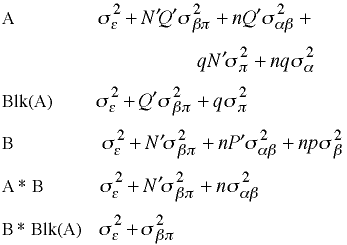
Sampling Fractions
When A is fixed P' = 0, when A is random P' = 1
When B is fixed Q' = 0, when B is random Q' = 1
When Blocks are fixed N' = 0, when Blocks are random N' = 1
Where P' is a short way of writing 1 - p/P. p/P is the sampling fraction.
P' = 1 - p/P
Q' = 1 - q/Q
N' = 1 - n/N
The Variance-Covariance Matrices
Computing the Variance-Covariance Matrices from Wide Data
input s a y1 y2 y3 y4
1 1 3 4 7 7
2 1 6 5 8 8
3 1 3 4 7 9
4 1 3 3 6 8
5 2 1 2 5 10
6 2 2 3 6 10
7 2 2 4 5 9
8 2 2 3 6 11
end
corr y1 y2 y3 y4 if a==1, cov
(obs=4)
| y1 y2 y3 y4
---------+------------------------------------
y1 | 2.25
y2 | 1 .666667
y3 | 1 .666667 .666667
y4 | 0 0 0 .666667
corr y1 y2 y3 y4 if a==2, cov
(obs=4)
| y1 y2 y3 y4
---------+------------------------------------
y1 | .25
y2 | .333333 .666667
y3 | .166667 0 .333333
y4 | 0 -.333333 .333333 .666667
Pooling the Variance-Covariance Matrices
b1 b2 b3 b4
b1 1.2500 .6667 .5834 0
b2 .6667 .6667 .3334 -.1667
b3 .5834 .3334 .5000 .1667
b4 0 -.1667 .1667 .6667
Obtaining the Pooled Variance-Covariance Matrice in Stata
anova y a / s|a b a#b /, repeated(b)
[output omitted]
mat lis e(Srep)
symmetric e(Srep)[4,4]
c1 c2 c3 c4
r1 1.25
r2 .66666667 .66666667
r3 .58333333 .33333333 .5
r4 0 -.16666667 .16666667 .66666667
Conservative F-ratios
Here are the results from the anova command displaying the conventional and conservative p-values.
Huynh-Feldt epsilon = 0.9432
Greenhouse-Geisser epsilon = 0.5841
Box's conservative epsilon = 0.3333
------------ Prob > F ------------
Source | df F Regular H-F G-G Box
-----------+----------------------------------------------------
b | 3 127.89 0.0000 0.0000 0.0000 0.0000
a*b | 3 12.74 0.0001 0.0002 0.0019 0.0118
Residual | 18
-----------+----------------------------------------------------Tests of Simple Main Effects
ANOVA Summary Table
| Source | SS | df | MS | F | Error Term | |
| Between Blocks | ||||||
| 1 | A at b1 | 8.000 | 1 | 8.000 | 10.38 | [5] |
| 2 | A at b2 | 2.000 | 1 | 2.000 | 2.59 | [5] |
| 3 | A at b3 | 4.500 | 1 | 4.500 | 5.84 | [5] |
| 4 | A at b4 | 8.000 | 1 | 8.000 | 10.38 | [5] |
| 5 | Within cell | 18.500 | 24 | .771 | ||
| Within Blocks | ||||||
| 6 | B at a1 | 54.687 | 3 | 18.229 | 35.95 | [9] |
| 7 | B at a2 | 159.187 | 3 | 53.062 | 104.66 | [9] |
| 8 | A*B | 19.375 | 3 | 6.458 | 12.74 | [9] |
| 9 | B*Blks(A) | 9.125 | 18 | 0.507 | ||
| Total | 235.500 | 31 | ||||
Using Stata
anova y a / s|a b a#b /, repeated(b)
Number of obs = 32 R-squared = 0.9613
Root MSE = .712 Adj R-squared = 0.9333
Source | Partial SS df MS F Prob > F
-----------+----------------------------------------------------
Model | 226.375 13 17.4134615 34.35 0.0000
|
a | 3.125 1 3.125 2.00 0.2070
s|a | 9.375 6 1.5625
-----------+----------------------------------------------------
b | 194.50 3 64.8333333 127.89 0.0000
a*b | 19.375 3 6.45833333 12.74 0.0001
|
Residual | 9.125 18 .506944444
-----------+----------------------------------------------------
Total | 235.50 31 7.59677419
Between-subjects error term: s|a
Levels: 8 (6 df)
Lowest b.s.e. variable: s
Covariance pooled over: a (for repeated variable)
Repeated variable: b
Huynh-Feldt epsilon = 0.9432
Greenhouse-Geisser epsilon = 0.5841
Box's conservative epsilon = 0.3333
------------ Prob > F ------------
Source | df F Regular H-F G-G Box
-----------+----------------------------------------------------
b | 3 127.89 0.0000 0.0000 0.0000 0.0000
a*b | 3 12.74 0.0001 0.0002 0.0019 0.0118
Residual | 18
-----------+----------------------------------------------------
sme a b, sse(18.5) dfe(24) /* combines df & ss for s|a and residual */
Test of a at b(1): F(1/24) = 10.378378
Test of a at b(2): F(1/24) = 2.5945946
Test of a at b(3): F(1/24) = 5.8378378
Test of a at b(4): F(1/24) = 10.378378
Critical value of F for alpha = .05 using ...
--------------------------------------------------
Dunn's procedure = 5.7165623
Marascuilo & Levin = 6.623745
per family error rate = 7.291317
simultaneous test procedure = 20.978425
sme b a
Test of b at a(1): F(3/18) = 35.958904
Test of b at a(2): F(3/18) = 104.67123
Critical value of F for alpha = .05 using ...
--------------------------------------------------
Dunn's procedure = 3.9538741
Marascuilo & Levin = 4.4443607
per family error rate = 3.9538741
simultaneous test procedure = 7.3122283
tkcomp b if a==1
Tukey-Kramer pairwise comparisons for variable b
studentized range critical value(.05, 4, 18) = 3.9970087
mean
grp vs grp group means dif TK-test
-------------------------------------------------------
1 vs 2 3.7500 4.0000 0.2500 0.7022
1 vs 3 3.7500 7.0000 3.2500 9.1292*
1 vs 4 3.7500 8.0000 4.2500 11.9382*
2 vs 3 4.0000 7.0000 3.0000 8.4270*
2 vs 4 4.0000 8.0000 4.0000 11.2360*
3 vs 4 7.0000 8.0000 1.0000 2.8090
tkcomp b if a==2
Tukey-Kramer pairwise comparisons for variable b
studentized range critical value(.05, 4, 18) = 3.9970087
mean
grp vs grp group means dif TK-test
-------------------------------------------------------
1 vs 2 1.7500 3.0000 1.2500 3.5112
1 vs 3 1.7500 5.5000 3.7500 10.5337*
1 vs 4 1.7500 10.0000 8.2500 23.1741*
2 vs 3 3.0000 5.5000 2.5000 7.0225*
2 vs 4 3.0000 10.0000 7.0000 19.6629*
3 vs 4 5.5000 10.0000 4.5000 12.6404*
Linear Mixed Models Approach
xtmixed y a##b || s:, var
Performing EM optimization:
Performing gradient-based optimization:
Iteration 0: log restricted-likelihood = -34.824381
Iteration 1: log restricted-likelihood = -34.824379
Computing standard errors:
Mixed-effects REML regression Number of obs = 32
Group variable: s Number of groups = 8
Obs per group: min = 4
avg = 4.0
max = 4
Wald chi2(7) = 423.89
Log restricted-likelihood = -34.824379 Prob > chi2 = 0.0000
------------------------------------------------------------------------------
y | Coef. Std. Err. z P>|z| [95% Conf. Interval]
-------------+----------------------------------------------------------------
2.a | -2 .6208193 -3.22 0.001 -3.216783 -.7832165
|
b |
2 | .25 .5034603 0.50 0.619 -.736764 1.236764
3 | 3.25 .5034603 6.46 0.000 2.263236 4.236764
4 | 4.25 .5034603 8.44 0.000 3.263236 5.236764
|
a#b |
2 2 | 1 .7120004 1.40 0.160 -.3954951 2.395495
2 3 | .5 .7120004 0.70 0.483 -.8954951 1.895495
2 4 | 4 .7120004 5.62 0.000 2.604505 5.395495
|
_cons | 3.75 .4389855 8.54 0.000 2.889604 4.610396
------------------------------------------------------------------------------
------------------------------------------------------------------------------
Random-effects Parameters | Estimate Std. Err. [95% Conf. Interval]
-----------------------------+------------------------------------------------
s: Identity |
var(_cons) | .2638887 .2294499 .0480071 1.450562
-----------------------------+------------------------------------------------
var(Residual) | .5069445 .1689815 .2637707 .9743036
------------------------------------------------------------------------------
LR test vs. linear regression: chibar2(01) = 3.30 Prob >= chibar2 = 0.0346
anovalator a b, main 2way fratio
anovalator main-effect for a
chi2(1) = 2.000001 p-value = .1572991
scaled as F-ratio = 2.000001
anovalator main-effect for b
chi2(3) = 383.67117 p-value = 7.619e-83
scaled as F-ratio = 127.89039
anovalator two-way interaction for a#b
chi2(3) = 38.219172 p-value = 2.540e-08
scaled as F-ratio = 12.739724
anovalator a b, simple fratio
anovalator test of simple main effects for a at(b=1)
chi2(1) = 10.37838 p-value = .001275
scaled as F-ratio = 10.37838
anovalator test of simple main effects for a at(b=2)
chi2(1) = 2.594595 p-value = .10722884
scaled as F-ratio = 2.594595
anovalator test of simple main effects for a at(b=3)
chi2(1) = 5.8378388 p-value = .01568508
scaled as F-ratio = 5.8378388
anovalator test of simple main effects for a at(b=4)
chi2(1) = 10.37838 p-value = .001275
scaled as F-ratio = 10.37838
anovalator b a, simple fratio
anovalator test of simple main effects for b at(a=1)
chi2(3) = 107.87669 p-value = 3.142e-23
scaled as F-ratio = 35.958898
anovalator test of simple main effects for b at(a=2)
chi2(3) = 314.01365 p-value = 9.217e-68
scaled as F-ratio = 104.67122
anovalator b , pair at(a=1) quietly
anovalator pairwise comparisons for b at(a=1)
Comparison Coef. Std. Err. z P>|z| [95% Conf. Interval]
1 vs 2 -.25 .50346 -.497 0.619 -1.236782 .7367822
1 vs 3 -3.25 .50346 -6.46 0.000 -4.236782 -2.263218
1 vs 4 -4.25 .50346 -8.44 0.000 -5.236782 -3.263218
2 vs 3 -3 .50346 -5.96 0.000 -3.986782 -2.013218
2 vs 4 -4 .50346 -7.95 0.000 -4.986782 -3.013218
3 vs 4 -1 .50346 -1.99 0.047 -1.986782 -.01321783
anovalator b , pair at(a=2) quietly
anovalator pairwise comparisons for b at(a=2)
Comparison Coef. Std. Err. z P>|z| [95% Conf. Interval]
1 vs 2 -1.25 .50346 -2.48 0.013 -2.236782 -.2632178
1 vs 3 -3.75 .50346 -7.45 0.000 -4.736782 -2.763218
1 vs 4 -8.25 .50346 -16.4 0.000 -9.236782 -7.263218
2 vs 3 -2.5 .50346 -4.97 0.000 -3.486782 -1.513218
2 vs 4 -7 .50346 -13.9 0.000 -7.986782 -6.013218
3 vs 4 -4.5 .50346 -8.94 0.000 -5.486782 -3.513218
Linear Statistical Models Course
Phil Ender, 17sep10, 9may06, 25apr06, 5may00, 12Feb98